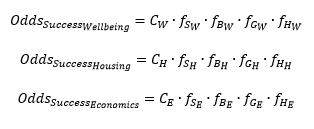Control is Futile
Success is a tall order because coordinating such a wide range of actions and aligning goals is complex. If we try to centralize control, the information and management systems needed would be immense. Imagine tracking a half dozen factors and a half dozen outcomes in each of a half dozen sectors, all the while sharing perspectives, leadership, and actions. Overwhelming. In fact, typical social systems involve more factors, outcomes and sectors than this.
Efforts using such techniques as Collective Impact as researched and documented by the Stanford Social Innovation Review have had some success with cross-sector coordination. Collective Impact, they find, requires a common agenda/shared vision, a shared measurement system, mutually reinforcing activities, continuous communication and a backbone support organization. The best examples of Collective Impact’s application have brought organizations together around one or two desired outcomes, such as cleaning up a polluted river or improving educational achievement, to rally multiple stakeholders to take coordinated action in mutually reinforcing activities.
However, our model suggests that this sort of approach – rallying stakeholders around a single outcome (or a small set of outcomes) – has its limits. At the very least, it is challenging to define a common agenda and shared vision that will be viewed as equally important for many different sectors (or park benches from my previous blog post). The outcomes that matter to different sectors are different. In fact, the model formulation suggests that the more stakeholders you bring to the table, the more challenging this will become. Yet, as we’ve established, all sectors matter and we need all sectors in.
The Collective Impact approach makes a nod to this challenge, by acknowledging that the central infrastructure, or backbone organization, must facilitate communication and coordination and must not control the actions of the participants. However, if organizations cannot agree on the “shared vision,” then they will never be successful in improving their community. Or will they?
Looking to Nature
I’ve always enjoyed examples of biomimicry – where engineers borrow solutions from the natural world to tackle challenging problems. Well known examples include the hook and loop of Velcro or the use of surfaces that imitate sharkskin so submarines can slip through the water with ease.
By employing some creative biomimicry of our own, I wonder if we can propose an alternative solution to the “shared vision” problem.
It turns out that in nature, there are many examples where multiple organisms work synchronously (if not cooperatively) even though the individuals never sit down as a group to define a shared vision. Okay, there are no examples in nature where animals, other than humans, sit down to define anything, so perhaps it is more accurate to say there are examples where no two individuals have exactly the same vision of the world. Instead, the individuals are driven in their self-serving desire to survive and be safe. Flocking birds such as starlings come immediately to my mind. They travel together, yet no single bird takes the lead. When threatened, they move in unison to avoid, confuse and confound their predators.
The Fundamentals Simplified
The foundation of our understanding of flocking behavior was first proposed by a Russian biologist, Dmitrii Radakov, in the 1960’s. He observed that schooling fish can successfully avoid a predator even if only a few fish know where the would-be predator is coming from. Each fish simply needs to coordinate their movements with those of surrounding fish. In this way, the few fish “in the know” can guide a huge school by initiating movements that are then imitated by their neighbors. The imitation wave propagates through the school. The result is highly democratic behavior where any fish can start the chain.
Mr. Radakov’s observations were later codified to create an algorithm. Eventually, computer programs used these algorithms to model flocking and schooling behavior to great success in such films as Disney’s The Lion King and Finding Nemo. The algorithms apply three simple rules to each member of the group:
- Each must be attracted to its own kind (they have an affinity to being close)
- Each must avoid colliding with its immediate neighbors (they stay close but not too close)
- Each must move in the same direction as the group (they go the same way)
Later observation revealed that in the real world, animals have a little broader vision. They actually pay attention to not just their immediate neighbors, but to the action in their local neighborhoods.

